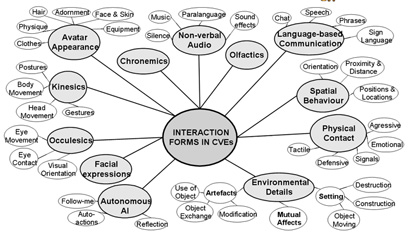The Hunt for Collaborative War Gaming - CASE: Battlefield 1942 by Tony Manninen and Tomi Kujanpää, Game Studies, Vol. 5, No.1, October 2005. The paper addresses a phenomenon connected to our research, namely the all the cues that users loose when playing remotely. The lack of face-to-face interaction indeed has important limits in terms of gamers interactions; which leads to new behavior like various forms of non-verbal communication and perceivable actions to reduce communication difficulties. The article hence describes describes and analyses the interaction forms that exist in a contemporary multiplayer 3D game to provide game designers with a model of " perceivable and holistic manifestations of interaction that enable players to fully collaborate and cooperate in networked game settings". It seems that the game studies (Battlefield 1942) offers supports a larger set of interaction forms than previously analysed FPS like Counter Strike.
the issue of collaborative perception, i.e., the possibilities to achieve shared situational awareness among the team members, becomes critical within the context of both virtual spatiality (e.g., large game worlds) and physical isolation (e.g., players communicate only via computer mediation). This means that the limited peripheral perception possibilities offered by contemporary multiplayer games should be supported by efficient communication channels and representational rendition of player actions within the manifested context of that particular individual.
The model they designed can be represented as follows:

The design suggestions originating from the study encourage the use and application of the rich interaction framework and the corresponding model. The results of analysis direct the design and development to support the creation of rich interaction. The primary emphasis is to avoid purely technologically driven design, and to focus instead on the creative process and conceptual understanding of rich interaction. The art assets can be designed in a way that they truly support cooperation and collaboration.
Why do I blog this? I worked on a similar project during my masters; with a peculiar emphasis on studying group awareness in FPS. This issue is very interesting and the results they came up with are worthwhile, especially in terms of collaboration-design. However, I was a bit surprised to see that the author do not refer to all the body of work derived from pragmatic linguistics which already addresses this issue (from a different viewpoint of course). The work of Clark and Brennan for instance could have been useful to analyse what is lost in this kind of context when it comes to communication, grounding (shared understanding of the situation...).